Brent Marchant's Blog, page 103
September 9, 2017
On the Radio This Week
Join host Frankie Picasso and yours truly this Tuesday, September 12, on the next edition of Mission Unstoppable radio, when we’ll interview documentary filmmaker Renée Scheltema about her excellent new release, “Normal Is Over” (web site, trailer). This engaging film presents an interesting take on sustainability and the effects of climate change, enlightening viewers about the real cause of this phenomenon.
Tune in at 1 pm ET by clicking here. And, for a review of the film, click here.

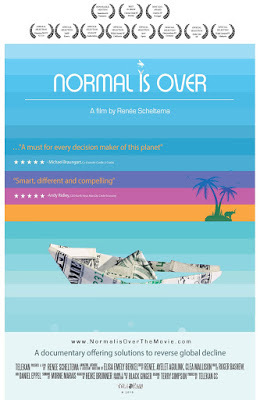
Tune in at 1 pm ET by clicking here. And, for a review of the film, click here.


Published on September 09, 2017 14:52
This Week in Movies with Meaning
Reviews of "Ingrid Goes West" and "Everything Is Copy," as well as a radio show preview, are all in this week's edition of Movies with Meaning on the web site of The Good Radio Network, available by clicking here.

 Writer-director-playwright Nora Ephron, the subject of "Everything Is Copy." Photo by Dan Greenburg, courtesy of HBO.
Writer-director-playwright Nora Ephron, the subject of "Everything Is Copy." Photo by Dan Greenburg, courtesy of HBO.



 Writer-director-playwright Nora Ephron, the subject of "Everything Is Copy." Photo by Dan Greenburg, courtesy of HBO.
Writer-director-playwright Nora Ephron, the subject of "Everything Is Copy." Photo by Dan Greenburg, courtesy of HBO.

Published on September 09, 2017 14:48
September 8, 2017
‘Ingrid Goes West’ skewers social media culture
“Ingrid Goes West” (2017). Cast: Aubrey Plaza, Elizabeth Olsen, O’Shea Jackson Jr., Wyatt Russell, Billy Magnusson, Pom Klementieff, Meredith Hagner. Director: Matt Spicer. Screenplay: David Branson Smith and Matt Spicer. Web site. Trailer.
We all want to be liked. But how far are we willing to go to achieve that outcome? And what if it gets the better of us, becoming an unhealthy obsession? That’s the stuff of which the incisive new comedy-drama “Ingrid Goes West” is made of.
Twentysomething Ingrid Thorburn (Aubrey Plaza) has issues. Most notably, she’s obsessed with being liked and popular, a compulsiveness driven by her nearly constant surfing of social media pages, where she ogles over the countless photos of smiling, happy people living cheerful, fun-loving, carefree, perfect lives. And, not to be left out, Ingrid wants some of that for herself. But, in her desire to attain such notoriety, sometimes Ingrid slips over the edge of reasonableness and common sense.
After an unfortunate incident at the wedding reception of one of her supposedly dear social media friends (Meredith Hagner) – an event to which Ingrid is not invited – she’s committed to a mental health facility to work out her problems. Upon her release, she’s allegedly cured, but, before long, she’s back online, hunting new besties to follow. This is especially important to Ingrid now since the one person who had been an important part of her life – her mother – passed away while she was undergoing treatment. It’s a sad and lonely time for the protagonist. But it’s also one where some of the sting of loss vanishes when she learns that her mother had left her an inheritance of $60,000.
While contemplating her future, Ingrid stumbles upon a potential new social media crush, a bubbly, effervescent, eminently photogenic Californian named Taylor Sloane (Elizabeth Olsen). Seemingly overnight, Taylor’s ubiquitous photos take over social media. She’s the person everyone is supposed to want to be, even though Taylor herself is one of those Kardashian-esque celebrities who has become famous for having done virtually nothing worthy of note. Yet, inspired by Taylor’s lifestyle, and with a wad of cash in hand, Ingrid decides to go west to meet the enviable Ms. Sloane.
 With her latest social media crush in tow, Internet stalker Ingrid Thorburn (Aubrey Plaza, right) poses for one of countless photos with cultural influencer Taylor Sloane (Elizabeth Olsen, left) in director Matt Spicer’s debut feature, “Ingrid Goes West.” Photo courtesy of Neon.
With her latest social media crush in tow, Internet stalker Ingrid Thorburn (Aubrey Plaza, right) poses for one of countless photos with cultural influencer Taylor Sloane (Elizabeth Olsen, left) in director Matt Spicer’s debut feature, “Ingrid Goes West.” Photo courtesy of Neon.
Once in California, Ingrid tracks down Taylor and begins hatching a plan to ingratiate herself into the life of the social media icon and her artist husband, Ezra (Wyatt Russell). In doing so, however, Ingrid engages in a series of questionable acts involving her landlord (O’Shea Jackson Jr.), Taylor’s crazy brother (Billy Magnusson) and even the happy couple’s dog. Ingrid gets away with her plans for a while, but, when her tactics – which are tantamount to clandestine stalking – are found out, she’s forced into taking even more drastic measures to cover her tracks. And all for the sake of a little attention.
So why is Ingrid so obsessive? Pure and simple, she’s lonely and wants to be liked. She feels left out, too, especially when she sees all the images of blissfully smiling faces pasted all over social media. But is forcefully inserting oneself into the lives of those individuals really the best course to follow?
Ingrid’s chief mistake in this is looking outside of herself for happiness. She believes that the external trappings associated with an active social (and active social media) life will bring her the joy and contentment she seeks. In doing this, she fails to grasp the principal message of conscious creation, the philosophy that maintains we manifest the reality we experience through the power of our thoughts, beliefs and intents – elements that originate from within us.
Indeed, if we want to enjoy a life of happiness, satisfaction and fulfillment, that has to begin with us. It comes from those very thoughts, beliefs and intents we employ to create the existence surrounding us. It can’t be extracted from an externalized materialization, no matter how seemingly elegant, glamorous or fun-filled it may appear. Until Ingrid comes to realize this, she’ll have to endure considerable discouragement, even at the hands of those who claim to be her friend. And it’s even more disillusioning when she learns that those who lead such supposedly enviable lives are engaged in acts of self-deception just as much as she is. The key question here is, who among them will come to this realization first – or at all?
One of the aims behind the creation of social media was the hope that it would bring people closer together. Ironically, though, it’s often had just the opposite effect. Many users have become disillusioned – even depressed – over what they see, wondering why their lives aren’t as fulfilled and perfect as those whose pictures they see online. This can result in increasing personal isolation or the extreme behavior exhibited by individuals like Ingrid. In either case, though, the dissatisfaction arises from those who brought it about in the first place for failing to recognize where their contentment truly originates.
This naturally raises the question, if this really is the result of this collective creation of ours, then why did we manifest it to begin with? That’s hard to say, but perhaps it’s because we need to go through this experience to get this essential lesson in reality creation. If the disappointment that comes from this helps to point us in the direction of the true source of where our happiness lies, then perhaps it’s a worthwhile effort, despite its associated difficulties. Should this be the case, though, we’d better pay attention.
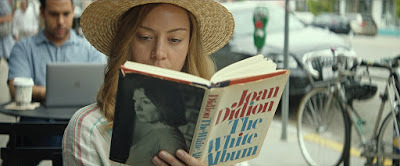 Ingrid Thorburn (Aubrey Plaza) mimics the habits of her latest social media crush – right down to her choice in reading materials – in the scathingly devastating new comedy-drama, “Ingrid Goes West.” Photo courtesy of Neon.
Ingrid Thorburn (Aubrey Plaza) mimics the habits of her latest social media crush – right down to her choice in reading materials – in the scathingly devastating new comedy-drama, “Ingrid Goes West.” Photo courtesy of Neon.
As a scathingly devastating dressing down of social media culture and our vapid fascination with today’s undeservedly overrated adult iterations of “the popular kids,” “Ingrid Goes West” hits the mark dead-on in a wide array of respects. Aubrey Plaza shows acting chops never seen before, delivering a solid, award-worthy performance in the role of the troubled title character. The protagonist’s portrayal is more than capably backed by a strong cast of supporting players who execute their roles with precision and insightful accuracy. And punctuating it all is a razor-sharp script peppered with big laughs that provide a perfect foil to the film’s darker, more dramatic moments.
Those who easily see through the thin veneer of what’s supposedly laudable these days will handily detect the unfortunate shallowness of many of our collective ways wickedly brought to life in this impressive debut feature from director Matt Spicer. Let’s hope the message sinks in – especially amongst those most in need of getting it.
Copyright © 2017, by Brent Marchant. All rights reserved.
We all want to be liked. But how far are we willing to go to achieve that outcome? And what if it gets the better of us, becoming an unhealthy obsession? That’s the stuff of which the incisive new comedy-drama “Ingrid Goes West” is made of.
Twentysomething Ingrid Thorburn (Aubrey Plaza) has issues. Most notably, she’s obsessed with being liked and popular, a compulsiveness driven by her nearly constant surfing of social media pages, where she ogles over the countless photos of smiling, happy people living cheerful, fun-loving, carefree, perfect lives. And, not to be left out, Ingrid wants some of that for herself. But, in her desire to attain such notoriety, sometimes Ingrid slips over the edge of reasonableness and common sense.
After an unfortunate incident at the wedding reception of one of her supposedly dear social media friends (Meredith Hagner) – an event to which Ingrid is not invited – she’s committed to a mental health facility to work out her problems. Upon her release, she’s allegedly cured, but, before long, she’s back online, hunting new besties to follow. This is especially important to Ingrid now since the one person who had been an important part of her life – her mother – passed away while she was undergoing treatment. It’s a sad and lonely time for the protagonist. But it’s also one where some of the sting of loss vanishes when she learns that her mother had left her an inheritance of $60,000.
While contemplating her future, Ingrid stumbles upon a potential new social media crush, a bubbly, effervescent, eminently photogenic Californian named Taylor Sloane (Elizabeth Olsen). Seemingly overnight, Taylor’s ubiquitous photos take over social media. She’s the person everyone is supposed to want to be, even though Taylor herself is one of those Kardashian-esque celebrities who has become famous for having done virtually nothing worthy of note. Yet, inspired by Taylor’s lifestyle, and with a wad of cash in hand, Ingrid decides to go west to meet the enviable Ms. Sloane.
 With her latest social media crush in tow, Internet stalker Ingrid Thorburn (Aubrey Plaza, right) poses for one of countless photos with cultural influencer Taylor Sloane (Elizabeth Olsen, left) in director Matt Spicer’s debut feature, “Ingrid Goes West.” Photo courtesy of Neon.
With her latest social media crush in tow, Internet stalker Ingrid Thorburn (Aubrey Plaza, right) poses for one of countless photos with cultural influencer Taylor Sloane (Elizabeth Olsen, left) in director Matt Spicer’s debut feature, “Ingrid Goes West.” Photo courtesy of Neon.Once in California, Ingrid tracks down Taylor and begins hatching a plan to ingratiate herself into the life of the social media icon and her artist husband, Ezra (Wyatt Russell). In doing so, however, Ingrid engages in a series of questionable acts involving her landlord (O’Shea Jackson Jr.), Taylor’s crazy brother (Billy Magnusson) and even the happy couple’s dog. Ingrid gets away with her plans for a while, but, when her tactics – which are tantamount to clandestine stalking – are found out, she’s forced into taking even more drastic measures to cover her tracks. And all for the sake of a little attention.
So why is Ingrid so obsessive? Pure and simple, she’s lonely and wants to be liked. She feels left out, too, especially when she sees all the images of blissfully smiling faces pasted all over social media. But is forcefully inserting oneself into the lives of those individuals really the best course to follow?
Ingrid’s chief mistake in this is looking outside of herself for happiness. She believes that the external trappings associated with an active social (and active social media) life will bring her the joy and contentment she seeks. In doing this, she fails to grasp the principal message of conscious creation, the philosophy that maintains we manifest the reality we experience through the power of our thoughts, beliefs and intents – elements that originate from within us.
Indeed, if we want to enjoy a life of happiness, satisfaction and fulfillment, that has to begin with us. It comes from those very thoughts, beliefs and intents we employ to create the existence surrounding us. It can’t be extracted from an externalized materialization, no matter how seemingly elegant, glamorous or fun-filled it may appear. Until Ingrid comes to realize this, she’ll have to endure considerable discouragement, even at the hands of those who claim to be her friend. And it’s even more disillusioning when she learns that those who lead such supposedly enviable lives are engaged in acts of self-deception just as much as she is. The key question here is, who among them will come to this realization first – or at all?
One of the aims behind the creation of social media was the hope that it would bring people closer together. Ironically, though, it’s often had just the opposite effect. Many users have become disillusioned – even depressed – over what they see, wondering why their lives aren’t as fulfilled and perfect as those whose pictures they see online. This can result in increasing personal isolation or the extreme behavior exhibited by individuals like Ingrid. In either case, though, the dissatisfaction arises from those who brought it about in the first place for failing to recognize where their contentment truly originates.
This naturally raises the question, if this really is the result of this collective creation of ours, then why did we manifest it to begin with? That’s hard to say, but perhaps it’s because we need to go through this experience to get this essential lesson in reality creation. If the disappointment that comes from this helps to point us in the direction of the true source of where our happiness lies, then perhaps it’s a worthwhile effort, despite its associated difficulties. Should this be the case, though, we’d better pay attention.
 Ingrid Thorburn (Aubrey Plaza) mimics the habits of her latest social media crush – right down to her choice in reading materials – in the scathingly devastating new comedy-drama, “Ingrid Goes West.” Photo courtesy of Neon.
Ingrid Thorburn (Aubrey Plaza) mimics the habits of her latest social media crush – right down to her choice in reading materials – in the scathingly devastating new comedy-drama, “Ingrid Goes West.” Photo courtesy of Neon.As a scathingly devastating dressing down of social media culture and our vapid fascination with today’s undeservedly overrated adult iterations of “the popular kids,” “Ingrid Goes West” hits the mark dead-on in a wide array of respects. Aubrey Plaza shows acting chops never seen before, delivering a solid, award-worthy performance in the role of the troubled title character. The protagonist’s portrayal is more than capably backed by a strong cast of supporting players who execute their roles with precision and insightful accuracy. And punctuating it all is a razor-sharp script peppered with big laughs that provide a perfect foil to the film’s darker, more dramatic moments.
Those who easily see through the thin veneer of what’s supposedly laudable these days will handily detect the unfortunate shallowness of many of our collective ways wickedly brought to life in this impressive debut feature from director Matt Spicer. Let’s hope the message sinks in – especially amongst those most in need of getting it.
Copyright © 2017, by Brent Marchant. All rights reserved.
Published on September 08, 2017 18:27
September 5, 2017
On the Radio Wednesday
Tune in for the latest Cinema Scribe segment on Bring Me 2 Life Radio's Seeker's Path show, tomorrow, September 6, at 12:30 pm ET, by clicking here (click on the "Shows" tab). And, if you don't hear it live, catch it later on the podcast!






Published on September 05, 2017 15:41
September 4, 2017
This Week in Movies with Meaning
Reviews of "Marjorie Prime" and "Shadows of Liberty," as well as details about an awards program, are all in the latest Movies with Meaning post on the web site of The Good Radio Network, available by clicking here.
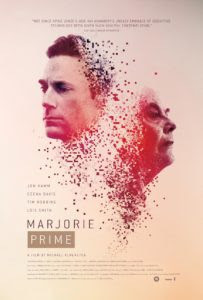
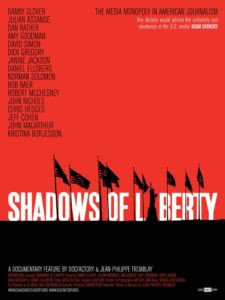






Published on September 04, 2017 08:14
September 3, 2017
‘Marjorie Prime’ wrestles with loss, the future of humanity
“Marjorie Prime” (2017). Cast: Jon Hamm, Geena Davis, Tim Robbins, Lois Smith, Stephanie Andujar, Hannah Gross, Azumi Tsutsui, Hana Colley, Leslie Lyles, Bill Walters. Director: Michael Almereyda. Screenplay: Michael Almereyda. Play: Jordan Harrison, Marjorie Prime. Web site. Trailer.
Coping with loss is something that most of us have had to deal with at some point in our lives. This can take a variety of forms, too, from the loss of a loved one to the loss of something we value to even the loss of some part of our own selves. How we handle such situations varies from person to person, depending on our individual circumstances and coping capabilities. Some of us soldier on, getting through the circumstances and moving on with our lives. But others among us may need some assistance in approaching these challenges, especially if they’re associated with strong emotions, a tremendous or unrelenting sense of loss, or unresolved aspects that prevent us from progressing. Such are the questions raised in the haunting new sci-fi drama, “Marjorie Prime.”
Aging senior Marjorie Lancaster (Lois Smith) suffers from acute dementia. She loses a little bit of herself every day, a painful process for others to witness, such as her daughter, Tess (Geena Davis), and son-in-law, Jon (Tim Robbins). Fortunately, in this society of the near future, technology has been developed to help those like Marjorie whose memories are continually slipping away into the oblivion of the ether.
Computer-generated holograms known as “primes” have been created to assist those afflicted with conditions like Marjorie’s. Primes are highly customizable forms of artificial intelligence that can interact with those to whom they’ve been assigned. They can take on the appearance of the assignee’s choice, assuming the looks, vocal inflections and mannerisms desired. They can even be programmed to simulate loved ones, providing patients with virtual versions of those who are near and dear to them, regardless of whether those whom they’re patterned after are living or dead. In this way, primes can provide a certain degree of comfort and continuity with those whom they’re designed to serve. And, when programmed with input from those familiar with their source individuals, primes can even be imprinted with the memories of their corporeal counterparts.
Primes who possess such qualities can thus carry on relationships with those whom they interact. In Marjorie’s case, she has chosen to become involved with a prime who resembles a middle-aged version of her late husband, Walter (Jon Hamm). He looks like the man she fell in love with and married, and he routinely reminisces with “his” spouse in hopes of stimulating her memory capabilities, a move Marjorie’s health care providers believe will help to slow the progress of her illness. At the same time, Marjorie’s conversations with Walter help to take her mind off of her condition, making her circumstances somewhat easier to cope with.
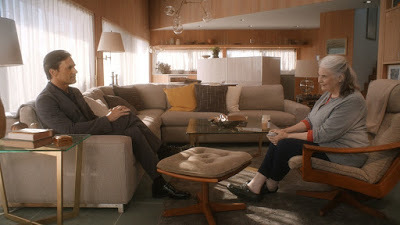 Aging dementia patient Marjorie Lancaster (Lois Smith, right) routinely reminisces with a computer-generated hologram known as a “prime” that resembles a middle-aged version of her late husband, Walter (Jon Hamm, left), as a means to help strengthen her memory in the inventive new sci-fi drama, “Marjorie Prime.” Photo by Jason Robinette, courtesy of FilmRise.
Aging dementia patient Marjorie Lancaster (Lois Smith, right) routinely reminisces with a computer-generated hologram known as a “prime” that resembles a middle-aged version of her late husband, Walter (Jon Hamm, left), as a means to help strengthen her memory in the inventive new sci-fi drama, “Marjorie Prime.” Photo by Jason Robinette, courtesy of FilmRise.
But primes are capable of doing more than offering comfort to the infirmed. They can be employed to help individuals cope with the loss of loved ones, especially those who have unresolved issues with those who have passed. Interactions with primes under these circumstances can help survivors talk out lingering questions that weren’t addressed before their flesh-and-blood twins died. Primes can even be imbued with qualities that their assignees wish their physical ancestors had possessed, making it possible to attain closure in a way that might not have been possible when dealing with the genuine artifact. Such attributes provide a degree of comfort to the living that might not have been available were it not for the creation of primes in the first place.
As a result of their development, primes thus bring a whole new meaning to what constitutes sentience, even what it means to be alive. The lines between those possessing intelligence of a natural and an artificial nature become blurred, especially when the differences distinguishing the two become harder to identify. In some ways, this speaks volumes about the capabilities of our technological developments. At the same time, though, it also raises questions about the future of what we consider humanity, issues that we might not be ready to address, no matter how adept the primes are at carrying out their assigned duties. The question then becomes, are we ready for that?
Practitioners of conscious creation – the philosophy that maintains we manifest the reality we experience through the power of our thoughts, beliefs and intents – readily recognize that we’re open to an infinite range of possibilities in any given moment, and this includes the myriad ways in which humanity can express itself. This opens up a tremendous number of new doors where matters of selfhood are concerned. And, in the context of what’s presented in “Marjorie Prime,” that means physicality need not be the quality that defines it – or limits it. Other options are available.
This should be self-evident, though; if we can conceive of an idea and earnestly believe in the possibility of its manifestation into existence, then all bets are off when it comes to applying hard and fast rules to the materialization process and what outcomes stem from it. Intelligence need not be limited by biochemical constraints; it may arise from what we consider to be “artificial” sources, in many ways mirroring or mimicking their “natural” counterparts. Something new and different but equally valid is given life, challenging long-held assumptions to the contrary.
 Tess (Geena Davis), daughter of an aging dementia patient, struggles to cope with her mother’s failing condition in director Michael Almereryda’s intriguing new release, “Marjorie Prime.” Photo by Jason Robinette, courtesy of FilmRise.
Tess (Geena Davis), daughter of an aging dementia patient, struggles to cope with her mother’s failing condition in director Michael Almereryda’s intriguing new release, “Marjorie Prime.” Photo by Jason Robinette, courtesy of FilmRise.
Some might think such notions as belonging only in the realm of science fiction. But, even if they can only be conceived in theoretical terms at this point, this does not rule out the potential of their eventual physical realization. For example, one need only look to the many hypothetical technologies envisioned in the early days of Star Trek that have since become full-fledged manifestations, even if their forms haven’t followed those of their fictional predecessors verbatim. And, when it comes to the ever-developing science of artificial intelligence, it’s easy to see how materializations in that area could just as easily follow suit, especially when backed by the powerful, highly focused beliefs of proponents (like scientist and inventor Ray Kurzweil), most of whom genuinely believe we’re well on our way to seeing such creations come into being.
Such thinking thus raises questions about how such technology would be used. As it’s employed in this film, for instance, artificial intelligence has been conceived of and subsequently employed for beneficial purposes, as seen in its use for helping to treat Marjorie’s condition. It could just as readily be used for some of the other aforementioned purposes as well. On the other hand, it could also be put to use for nefarious reasons, the consequences of which could be devastating. And, if potential deleterious ramifications are disregarded – even if the technology is launched with the best of intentions – such a lack of foresight and responsibility could produce results that are equally ruinous.
In any of these scenarios, it’s incumbent upon us to take stock of our beliefs, since they will determine what arises from them. “Marjorie Prime” helps to draw attention to these matters, showing us the benefits and possible drawbacks that can come from our conceptions and their resulting materializations. The technology at the heart of this story holds the potential to do a world of good. It can help us to redefine our notions about humanity and existence. It can enable us to surpass limitations in our beliefs and open doors to a host of glorious new inventions and applications. But, if we’re not careful in how we form and manage our beliefs, it can also lead us down paths we’d best leave unexplored. The question thus becomes, what are we going to do?
In many ways, the film leaves this question open while exploring a host of belief possibilities in terms of how we see ourselves, how we make use of our envisioned creations and what results from all that. No matter what results, however, in every case we can trace back their origins to the same intangible source, one that we all access, manage and employ in the materialization of the world that arises around us.
 Walter (Jon Hamm, right), a computer-generated hologram known as a “prime,” receives background information about the life of the dementia patient he’s assigned to work with from the infirmed’s son-in-law, Jon (Tim Robbins, left), in the haunting new sci-fi drama, “Marjorie Prime.” Photo by Jason Robinette, courtesy of FilmRise.
Walter (Jon Hamm, right), a computer-generated hologram known as a “prime,” receives background information about the life of the dementia patient he’s assigned to work with from the infirmed’s son-in-law, Jon (Tim Robbins, left), in the haunting new sci-fi drama, “Marjorie Prime.” Photo by Jason Robinette, courtesy of FilmRise.
“Marjorie Prime” is a thoughtful, insightful look at coping with grief, promoting healing, reconciling interpersonal discord, preserving memory, growing comfortable with technology, assessing the nature of reality and contemplating the fate of human evolution, all wrapped up in an intimate, beautifully filmed, well-acted, smartly conceived package. Although the script at times doesn’t quite rise up to the level of its narrative and Pulitzer Prize-nominated source material, the film nevertheless touches many bases and gives viewers much to ponder. With an excellent ensemble cast, highlighted by a superb performance by long-underappreciated character actress Lois Smith, this latest production from director Michael Almereyda once again distinguishes the filmmaker as one of today’s most inventive, ambitious and underrated talents in the business. “Marjorie Prime” may be a little difficult to find, playing primarily in theaters specializing in independent cinema, but it’s well worth the search.
Who we are and what we become are questions we all wrestle with, sometimes for large expanses of our lives. But, along the way, we’re also left to address a number of considerations that characterize the state of the human experience. How we respond and cope under such circumstances affords us an opportunity to learn valuable life lessons and to contribute to our understanding of the unfolding of the human condition, no matter how our beliefs shape the outcome and what form it ultimately may take. “Marjorie Prime” provides us with an intriguing look at those concerns and how we might learn from them in the formation of our own reality.
Copyright © 2017, by Brent Marchant. All rights reserved.
Coping with loss is something that most of us have had to deal with at some point in our lives. This can take a variety of forms, too, from the loss of a loved one to the loss of something we value to even the loss of some part of our own selves. How we handle such situations varies from person to person, depending on our individual circumstances and coping capabilities. Some of us soldier on, getting through the circumstances and moving on with our lives. But others among us may need some assistance in approaching these challenges, especially if they’re associated with strong emotions, a tremendous or unrelenting sense of loss, or unresolved aspects that prevent us from progressing. Such are the questions raised in the haunting new sci-fi drama, “Marjorie Prime.”
Aging senior Marjorie Lancaster (Lois Smith) suffers from acute dementia. She loses a little bit of herself every day, a painful process for others to witness, such as her daughter, Tess (Geena Davis), and son-in-law, Jon (Tim Robbins). Fortunately, in this society of the near future, technology has been developed to help those like Marjorie whose memories are continually slipping away into the oblivion of the ether.
Computer-generated holograms known as “primes” have been created to assist those afflicted with conditions like Marjorie’s. Primes are highly customizable forms of artificial intelligence that can interact with those to whom they’ve been assigned. They can take on the appearance of the assignee’s choice, assuming the looks, vocal inflections and mannerisms desired. They can even be programmed to simulate loved ones, providing patients with virtual versions of those who are near and dear to them, regardless of whether those whom they’re patterned after are living or dead. In this way, primes can provide a certain degree of comfort and continuity with those whom they’re designed to serve. And, when programmed with input from those familiar with their source individuals, primes can even be imprinted with the memories of their corporeal counterparts.
Primes who possess such qualities can thus carry on relationships with those whom they interact. In Marjorie’s case, she has chosen to become involved with a prime who resembles a middle-aged version of her late husband, Walter (Jon Hamm). He looks like the man she fell in love with and married, and he routinely reminisces with “his” spouse in hopes of stimulating her memory capabilities, a move Marjorie’s health care providers believe will help to slow the progress of her illness. At the same time, Marjorie’s conversations with Walter help to take her mind off of her condition, making her circumstances somewhat easier to cope with.
 Aging dementia patient Marjorie Lancaster (Lois Smith, right) routinely reminisces with a computer-generated hologram known as a “prime” that resembles a middle-aged version of her late husband, Walter (Jon Hamm, left), as a means to help strengthen her memory in the inventive new sci-fi drama, “Marjorie Prime.” Photo by Jason Robinette, courtesy of FilmRise.
Aging dementia patient Marjorie Lancaster (Lois Smith, right) routinely reminisces with a computer-generated hologram known as a “prime” that resembles a middle-aged version of her late husband, Walter (Jon Hamm, left), as a means to help strengthen her memory in the inventive new sci-fi drama, “Marjorie Prime.” Photo by Jason Robinette, courtesy of FilmRise.But primes are capable of doing more than offering comfort to the infirmed. They can be employed to help individuals cope with the loss of loved ones, especially those who have unresolved issues with those who have passed. Interactions with primes under these circumstances can help survivors talk out lingering questions that weren’t addressed before their flesh-and-blood twins died. Primes can even be imbued with qualities that their assignees wish their physical ancestors had possessed, making it possible to attain closure in a way that might not have been possible when dealing with the genuine artifact. Such attributes provide a degree of comfort to the living that might not have been available were it not for the creation of primes in the first place.
As a result of their development, primes thus bring a whole new meaning to what constitutes sentience, even what it means to be alive. The lines between those possessing intelligence of a natural and an artificial nature become blurred, especially when the differences distinguishing the two become harder to identify. In some ways, this speaks volumes about the capabilities of our technological developments. At the same time, though, it also raises questions about the future of what we consider humanity, issues that we might not be ready to address, no matter how adept the primes are at carrying out their assigned duties. The question then becomes, are we ready for that?
Practitioners of conscious creation – the philosophy that maintains we manifest the reality we experience through the power of our thoughts, beliefs and intents – readily recognize that we’re open to an infinite range of possibilities in any given moment, and this includes the myriad ways in which humanity can express itself. This opens up a tremendous number of new doors where matters of selfhood are concerned. And, in the context of what’s presented in “Marjorie Prime,” that means physicality need not be the quality that defines it – or limits it. Other options are available.
This should be self-evident, though; if we can conceive of an idea and earnestly believe in the possibility of its manifestation into existence, then all bets are off when it comes to applying hard and fast rules to the materialization process and what outcomes stem from it. Intelligence need not be limited by biochemical constraints; it may arise from what we consider to be “artificial” sources, in many ways mirroring or mimicking their “natural” counterparts. Something new and different but equally valid is given life, challenging long-held assumptions to the contrary.
 Tess (Geena Davis), daughter of an aging dementia patient, struggles to cope with her mother’s failing condition in director Michael Almereryda’s intriguing new release, “Marjorie Prime.” Photo by Jason Robinette, courtesy of FilmRise.
Tess (Geena Davis), daughter of an aging dementia patient, struggles to cope with her mother’s failing condition in director Michael Almereryda’s intriguing new release, “Marjorie Prime.” Photo by Jason Robinette, courtesy of FilmRise.Some might think such notions as belonging only in the realm of science fiction. But, even if they can only be conceived in theoretical terms at this point, this does not rule out the potential of their eventual physical realization. For example, one need only look to the many hypothetical technologies envisioned in the early days of Star Trek that have since become full-fledged manifestations, even if their forms haven’t followed those of their fictional predecessors verbatim. And, when it comes to the ever-developing science of artificial intelligence, it’s easy to see how materializations in that area could just as easily follow suit, especially when backed by the powerful, highly focused beliefs of proponents (like scientist and inventor Ray Kurzweil), most of whom genuinely believe we’re well on our way to seeing such creations come into being.
Such thinking thus raises questions about how such technology would be used. As it’s employed in this film, for instance, artificial intelligence has been conceived of and subsequently employed for beneficial purposes, as seen in its use for helping to treat Marjorie’s condition. It could just as readily be used for some of the other aforementioned purposes as well. On the other hand, it could also be put to use for nefarious reasons, the consequences of which could be devastating. And, if potential deleterious ramifications are disregarded – even if the technology is launched with the best of intentions – such a lack of foresight and responsibility could produce results that are equally ruinous.
In any of these scenarios, it’s incumbent upon us to take stock of our beliefs, since they will determine what arises from them. “Marjorie Prime” helps to draw attention to these matters, showing us the benefits and possible drawbacks that can come from our conceptions and their resulting materializations. The technology at the heart of this story holds the potential to do a world of good. It can help us to redefine our notions about humanity and existence. It can enable us to surpass limitations in our beliefs and open doors to a host of glorious new inventions and applications. But, if we’re not careful in how we form and manage our beliefs, it can also lead us down paths we’d best leave unexplored. The question thus becomes, what are we going to do?
In many ways, the film leaves this question open while exploring a host of belief possibilities in terms of how we see ourselves, how we make use of our envisioned creations and what results from all that. No matter what results, however, in every case we can trace back their origins to the same intangible source, one that we all access, manage and employ in the materialization of the world that arises around us.
 Walter (Jon Hamm, right), a computer-generated hologram known as a “prime,” receives background information about the life of the dementia patient he’s assigned to work with from the infirmed’s son-in-law, Jon (Tim Robbins, left), in the haunting new sci-fi drama, “Marjorie Prime.” Photo by Jason Robinette, courtesy of FilmRise.
Walter (Jon Hamm, right), a computer-generated hologram known as a “prime,” receives background information about the life of the dementia patient he’s assigned to work with from the infirmed’s son-in-law, Jon (Tim Robbins, left), in the haunting new sci-fi drama, “Marjorie Prime.” Photo by Jason Robinette, courtesy of FilmRise.“Marjorie Prime” is a thoughtful, insightful look at coping with grief, promoting healing, reconciling interpersonal discord, preserving memory, growing comfortable with technology, assessing the nature of reality and contemplating the fate of human evolution, all wrapped up in an intimate, beautifully filmed, well-acted, smartly conceived package. Although the script at times doesn’t quite rise up to the level of its narrative and Pulitzer Prize-nominated source material, the film nevertheless touches many bases and gives viewers much to ponder. With an excellent ensemble cast, highlighted by a superb performance by long-underappreciated character actress Lois Smith, this latest production from director Michael Almereyda once again distinguishes the filmmaker as one of today’s most inventive, ambitious and underrated talents in the business. “Marjorie Prime” may be a little difficult to find, playing primarily in theaters specializing in independent cinema, but it’s well worth the search.
Who we are and what we become are questions we all wrestle with, sometimes for large expanses of our lives. But, along the way, we’re also left to address a number of considerations that characterize the state of the human experience. How we respond and cope under such circumstances affords us an opportunity to learn valuable life lessons and to contribute to our understanding of the unfolding of the human condition, no matter how our beliefs shape the outcome and what form it ultimately may take. “Marjorie Prime” provides us with an intriguing look at those concerns and how we might learn from them in the formation of our own reality.
Copyright © 2017, by Brent Marchant. All rights reserved.
Published on September 03, 2017 20:10
August 31, 2017
‘Dave Made a Maze’ explores the labyrinth of consciousness
“Dave Made a Maze” (2017). Cast: Nick Thune, Meera Rohit Kumbhani, Adam Busch, James Urbaniak, Scott Krinsky, Frank Caeti, Scott Narver, Kirsten Vangsness, Timothy Nordwind, Stephanie Allynne, Rick Overton, John Hennigan, Kamilla Alnes, Drew Knigga. Director: Bill Watterson. Screenplay: Steven Sears and Bill Watterson. Story: Steven Sears. Web site. Trailer.
What lurks inside our mind? Most of us probably just scratch the surface of what’s there. Some aspects of it would probably delight us, while others would likely be best left unexamined. But we’ll never know exactly what’s there unless we make an attempt to go in and explore the labyrinth of our consciousness. That can be especially tempting if we feel unfulfilled in our lives. However, should we embark on such an undertaking, we’d be wise to prepare for it, particularly when it comes to getting ready for the unexpected. Such is the quest of a melancholic thirtysomething in the unusual new indie release, “Dave Made a Maze.”
Dave (Nick Thune) is an aspiring artist who never finishes any of the projects he starts. He’s also frustrated that he spends his days working at jobs he hates, making little money and having nothing substantial to show for it. He longs for the experience of creative fulfillment, but it always seems to elude him – that is, until one weekend, when he’s home alone. With his significant other, Annie (Meera Rohit Kumbhani), out of town, he throws himself into a new artistic venture, the construction of a cardboard maze in his living room.
On the surface, the project probably seems like a fairly simple undertaking. But, the further Dave gets into it, the more he stumbles into a wrinkle that starts out annoying and progressively grows troubling. He discovers that the maze, from the inside, is considerably larger and more complex than from the outside – so much so, in fact, that he can’t find his way out. He feels lost and trapped, not sure how to proceed, especially when he learns that the maze also contains dangers that he hadn’t anticipated. What is he to do now?
When Annie returns from her trip, she’s surprised when she finds the cardboard structure before her and no sign of Dave. But, soon after her arrival, Dave hears her moving about the living room, and he calls out to her from inside the maze. He explains his situation but cautions her not to enter it because of the inherent danger. He asks her to contact his best friend, Gordon (Adam Busch), to see if he can come up with ideas for how he might make his escape.
Before long, Gordon joins Annie with a cavalcade of others in tow, including his friends Leonard (Scott Krinsky) and Jane (Kirsten Vangsness), hipster pals Greg (Timothy Nordwind) and Brynn (Stephanie Allynne), and an indie film crew (James Urbaniak, Frank Caeti, Scott Narver) that, for some reason, is fascinated with wanting to document events as they unfold. Everyone is intrigued by the maze, and they all want to go inside, despite Dave’s cautions. However, this eclectic cadre of curiosity seekers is soon overcome by temptation. They disregard the warnings and enter, where they quickly find that everything Dave said is true.
As the newly arrived explorers make their way through the maze, they find all manner of strange curiosities, some whimsical and fun, some enticing, some menacing, and some deadly. But, thankfully, in the course of their wanderings, they run into Dave, who helps guide the visitors through the structure. In the process, he and the others also discover new aspects of the labyrinth that he hadn’t come across before. At the same time, they also learn that a new danger lurks inside – a ferocious Minotaur (John Hennigan) determined to take out the uninvited strangers who have invaded his turf.
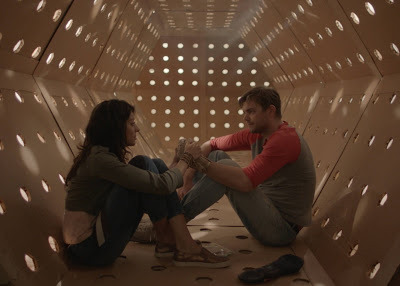 Aspiring artist Dave (Nick Thune, right) and his significant other, Annie (Meera Rohit Kumbhani, left), contemplate how to escape from a maze that threatens to trap them in the quirky new indie romp, “Dave Made a Maze.” Photo courtesy of Gravitas Ventures.
Aspiring artist Dave (Nick Thune, right) and his significant other, Annie (Meera Rohit Kumbhani, left), contemplate how to escape from a maze that threatens to trap them in the quirky new indie romp, “Dave Made a Maze.” Photo courtesy of Gravitas Ventures.
With this new threat now breathing down their necks, Dave and his cohorts are more motivated than ever to find a way out. But looking for a physical exit doesn’t seem to be a viable solution. Dave soon realizes that he must discover what’s preventing their escape, a process that requires him to look within his own mind. Given that the maze has come to physically symbolize the labyrinth of his consciousness, he must try to determine what has given the maze its shape and composition, something he learns rests with his beliefs and outlooks about life, his existence and his reason for being. Understanding those influences holds the key to helping him find his way clear. But the question remains, will he accept what he finds and abide by what he knows he needs to do to be able to get out of the maze?
This film readily brings to mind the principles of conscious creation, the philosophy that maintains we manifest the reality we experience through the power of our thoughts, beliefs and intents. If Dave is to resolve his circumstances, he must come to terms with what it means to be him, taking a hard look at his beliefs and how they have come to shape the nature and components of his existence. This is most crucial when it comes to his feelings about creative fulfillment and his habit of never following through on his projects. Why do his beliefs in these areas form as they do? That’s something he needs to analyze in depth, even if that means examining aspects of himself and his life that go beyond these considerations. His willingness to take on this task could well determine his fate and that of those who have accompanied him on his odyssey.
But there are other beliefs Dave needs to consider, too. For example, by routinely abandoning the projects he starts, he’s abrogating his sense of responsibility for his creations, a core consideration that goes hand in hand with what we manifest. Given how conscious creation works, however, we can’t realistically disavow ourselves from this aspect of the materialization process. Yet, considering Dave’s track record, he somehow seems to believe that he can, failing to recognize the various implications that accompany such an outlook. To begin with, casually shrugging off his projects keeps Dave from taking ownership of his manifestations while simultaneously perpetuating his feelings of frustration over never finishing anything. But, perhaps worse, his failure to embrace his sense of responsibility leaves him unprepared for what might happen if he should ever happen to follow through on one of his projects to completion. Because of his shortcoming in this area, and given how committed he seems to be to actually complete his venture this time, he’s overwhelmed by the responsibility – and the ramifications – that now stare him squarely in the face as he proceeds toward culmination. It’s especially important in this case, because his efforts carry the potential to seriously impact others besides him.
If Dave is ever going to get serious about his manifestation efforts, he needs to examine his beliefs – all of them – to understand how they shape what unfolds in his reality, especially those elements that have the potential to affect others besides himself. This is often true where artists are concerned, since their works frequently have influence that extends beyond themselves. And, given Dave’s aspirations, he’s no exception to this. The question, of course, is, can he step up to the plate and assume the responsibility that goes with his creations and their underlying beliefs? It seems that, now, as he peruses the corridors of his labyrinth of consciousness, he has an opportunity to find out. If he’s sincere about attaining the success he claims he’s seeking, one can only hope that he’s willing to make the effort – and up to the challenge.
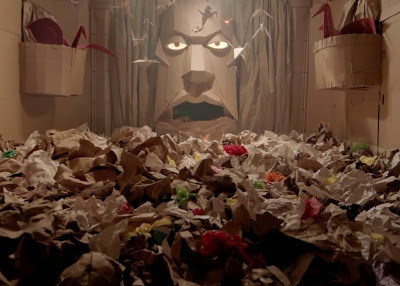 Creative visual effects using elaborate works of origami characterize the world inside an unusual labyrinth in director Bill Watterson’s debut feature, “Dave Made a Maze.” Photo courtesy of Gravitas Ventures.
Creative visual effects using elaborate works of origami characterize the world inside an unusual labyrinth in director Bill Watterson’s debut feature, “Dave Made a Maze.” Photo courtesy of Gravitas Ventures.
Fortunately for his sake, he’s got the maze itself to draw from in seeking inspiration. As a physically manifested expression of his consciousness, this complicated structure, with its seemingly endless complex of corridors, symbolizes the many components of Dave’s mind, one that’s tapped into the infinite range of possibilities for materialization always available to him. The key consideration in this, of course, is, will he make the effort to recognize, acknowledge and accept these capabilities? And, if so, will he then act upon them?
If Dave is going to make use of this resource, he needs to consider the breadth of options open to him, especially those that break through the self-imposed limitations that have previously held him back. By thinking outside the box – or outside the maze – Dave has a chance to conceive of and follow through on possibilities he hadn’t considered before. Doing so could pay significant dividends, too, such as enabling him to envision and manifest creations never dreamed of before. It just might get him to actually complete a project for once (or, at the very least, to help him find a way out of the maze).
Dave has a powerful incentive to follow through on this, too, now that he’s being stalked by a force with the potential to do him in, the Minotaur. Some might legitimately wonder why he would have manifested such a threat in the first place, but, in actuality, this creation could be seen as a blessing in disguise. By materializing such a menacing creature, Dave has drawn to him something that keeps him focused and intent on following through on his goal, a purpose not unlike the one served by the presence of the Wicked Witch of the West in “The Wizard of Oz” (1939). With the Minotaur constantly breathing down his neck, Dave has an opportunity to galvanize himself in his beliefs, particularly those related to determination, completion, fulfillment and the anticipated satisfaction that comes from all that. Considering the potential rewards of his efforts, a little well-intentioned intimidation could go a long way toward ultimately reaching a cherished goal. And that could prove to be the ultimate escape, one that liberates us from what we needlessly allow to hold ourselves back.
 A ferocious Minotaur (John Hennigan) prowls the corridors of an unusual maze, threatening to attack a host of uninvited visitors who’ve made their way onto his turf in the inventive new homage to ʼ80s fantasy adventure films, “Dave Made a Maze.” Photo by Chelsea Coleman, courtesy of Gravitas Ventures.
A ferocious Minotaur (John Hennigan) prowls the corridors of an unusual maze, threatening to attack a host of uninvited visitors who’ve made their way onto his turf in the inventive new homage to ʼ80s fantasy adventure films, “Dave Made a Maze.” Photo by Chelsea Coleman, courtesy of Gravitas Ventures.
There’s much more than meets the eye going on in director Bill Watterson’s debut feature. This quirky, fun-filled romp pays an edgy homage to ʼ80s fantasy adventure films like “Labyrinth” (1986), “The Dark Crystal” (1982), “The NeverEnding Story” (1984) and “Explorers” (1985), featuring inventive cinematography and a variety of clever special effects, some involving such unusual elements as puppets and elaborate forms of origami. It also serves up its share of big, sometimes-cheeky laughs. But there’s considerable food for thought here, too, making for an interesting overall mix of influences. “Dave Made a Maze” may be a little hard to find in theaters, but it’s available for on-demand streaming and will be released on DVD and Blu-ray Disc in the near future.
Learning what it means to live out one’s destiny may take some work, some of it internally and not just from the toil of one’s brow. But that part, though intangible, might ultimately prove more difficult, especially if we’re reluctant to do the work. Yet, if we make the effort to comply, we could find that the rest flows freely, providing the sought-after fulfillment that was once thought to be ever elusive. By working through the maze of our consciousness, we just might find our way out – and on to a path of satisfaction beyond expectation.
Copyright © 2017, by Brent Marchant. All rights reserved.
What lurks inside our mind? Most of us probably just scratch the surface of what’s there. Some aspects of it would probably delight us, while others would likely be best left unexamined. But we’ll never know exactly what’s there unless we make an attempt to go in and explore the labyrinth of our consciousness. That can be especially tempting if we feel unfulfilled in our lives. However, should we embark on such an undertaking, we’d be wise to prepare for it, particularly when it comes to getting ready for the unexpected. Such is the quest of a melancholic thirtysomething in the unusual new indie release, “Dave Made a Maze.”
Dave (Nick Thune) is an aspiring artist who never finishes any of the projects he starts. He’s also frustrated that he spends his days working at jobs he hates, making little money and having nothing substantial to show for it. He longs for the experience of creative fulfillment, but it always seems to elude him – that is, until one weekend, when he’s home alone. With his significant other, Annie (Meera Rohit Kumbhani), out of town, he throws himself into a new artistic venture, the construction of a cardboard maze in his living room.
On the surface, the project probably seems like a fairly simple undertaking. But, the further Dave gets into it, the more he stumbles into a wrinkle that starts out annoying and progressively grows troubling. He discovers that the maze, from the inside, is considerably larger and more complex than from the outside – so much so, in fact, that he can’t find his way out. He feels lost and trapped, not sure how to proceed, especially when he learns that the maze also contains dangers that he hadn’t anticipated. What is he to do now?
When Annie returns from her trip, she’s surprised when she finds the cardboard structure before her and no sign of Dave. But, soon after her arrival, Dave hears her moving about the living room, and he calls out to her from inside the maze. He explains his situation but cautions her not to enter it because of the inherent danger. He asks her to contact his best friend, Gordon (Adam Busch), to see if he can come up with ideas for how he might make his escape.
Before long, Gordon joins Annie with a cavalcade of others in tow, including his friends Leonard (Scott Krinsky) and Jane (Kirsten Vangsness), hipster pals Greg (Timothy Nordwind) and Brynn (Stephanie Allynne), and an indie film crew (James Urbaniak, Frank Caeti, Scott Narver) that, for some reason, is fascinated with wanting to document events as they unfold. Everyone is intrigued by the maze, and they all want to go inside, despite Dave’s cautions. However, this eclectic cadre of curiosity seekers is soon overcome by temptation. They disregard the warnings and enter, where they quickly find that everything Dave said is true.
As the newly arrived explorers make their way through the maze, they find all manner of strange curiosities, some whimsical and fun, some enticing, some menacing, and some deadly. But, thankfully, in the course of their wanderings, they run into Dave, who helps guide the visitors through the structure. In the process, he and the others also discover new aspects of the labyrinth that he hadn’t come across before. At the same time, they also learn that a new danger lurks inside – a ferocious Minotaur (John Hennigan) determined to take out the uninvited strangers who have invaded his turf.
 Aspiring artist Dave (Nick Thune, right) and his significant other, Annie (Meera Rohit Kumbhani, left), contemplate how to escape from a maze that threatens to trap them in the quirky new indie romp, “Dave Made a Maze.” Photo courtesy of Gravitas Ventures.
Aspiring artist Dave (Nick Thune, right) and his significant other, Annie (Meera Rohit Kumbhani, left), contemplate how to escape from a maze that threatens to trap them in the quirky new indie romp, “Dave Made a Maze.” Photo courtesy of Gravitas Ventures.With this new threat now breathing down their necks, Dave and his cohorts are more motivated than ever to find a way out. But looking for a physical exit doesn’t seem to be a viable solution. Dave soon realizes that he must discover what’s preventing their escape, a process that requires him to look within his own mind. Given that the maze has come to physically symbolize the labyrinth of his consciousness, he must try to determine what has given the maze its shape and composition, something he learns rests with his beliefs and outlooks about life, his existence and his reason for being. Understanding those influences holds the key to helping him find his way clear. But the question remains, will he accept what he finds and abide by what he knows he needs to do to be able to get out of the maze?
This film readily brings to mind the principles of conscious creation, the philosophy that maintains we manifest the reality we experience through the power of our thoughts, beliefs and intents. If Dave is to resolve his circumstances, he must come to terms with what it means to be him, taking a hard look at his beliefs and how they have come to shape the nature and components of his existence. This is most crucial when it comes to his feelings about creative fulfillment and his habit of never following through on his projects. Why do his beliefs in these areas form as they do? That’s something he needs to analyze in depth, even if that means examining aspects of himself and his life that go beyond these considerations. His willingness to take on this task could well determine his fate and that of those who have accompanied him on his odyssey.
But there are other beliefs Dave needs to consider, too. For example, by routinely abandoning the projects he starts, he’s abrogating his sense of responsibility for his creations, a core consideration that goes hand in hand with what we manifest. Given how conscious creation works, however, we can’t realistically disavow ourselves from this aspect of the materialization process. Yet, considering Dave’s track record, he somehow seems to believe that he can, failing to recognize the various implications that accompany such an outlook. To begin with, casually shrugging off his projects keeps Dave from taking ownership of his manifestations while simultaneously perpetuating his feelings of frustration over never finishing anything. But, perhaps worse, his failure to embrace his sense of responsibility leaves him unprepared for what might happen if he should ever happen to follow through on one of his projects to completion. Because of his shortcoming in this area, and given how committed he seems to be to actually complete his venture this time, he’s overwhelmed by the responsibility – and the ramifications – that now stare him squarely in the face as he proceeds toward culmination. It’s especially important in this case, because his efforts carry the potential to seriously impact others besides him.
If Dave is ever going to get serious about his manifestation efforts, he needs to examine his beliefs – all of them – to understand how they shape what unfolds in his reality, especially those elements that have the potential to affect others besides himself. This is often true where artists are concerned, since their works frequently have influence that extends beyond themselves. And, given Dave’s aspirations, he’s no exception to this. The question, of course, is, can he step up to the plate and assume the responsibility that goes with his creations and their underlying beliefs? It seems that, now, as he peruses the corridors of his labyrinth of consciousness, he has an opportunity to find out. If he’s sincere about attaining the success he claims he’s seeking, one can only hope that he’s willing to make the effort – and up to the challenge.
 Creative visual effects using elaborate works of origami characterize the world inside an unusual labyrinth in director Bill Watterson’s debut feature, “Dave Made a Maze.” Photo courtesy of Gravitas Ventures.
Creative visual effects using elaborate works of origami characterize the world inside an unusual labyrinth in director Bill Watterson’s debut feature, “Dave Made a Maze.” Photo courtesy of Gravitas Ventures.Fortunately for his sake, he’s got the maze itself to draw from in seeking inspiration. As a physically manifested expression of his consciousness, this complicated structure, with its seemingly endless complex of corridors, symbolizes the many components of Dave’s mind, one that’s tapped into the infinite range of possibilities for materialization always available to him. The key consideration in this, of course, is, will he make the effort to recognize, acknowledge and accept these capabilities? And, if so, will he then act upon them?
If Dave is going to make use of this resource, he needs to consider the breadth of options open to him, especially those that break through the self-imposed limitations that have previously held him back. By thinking outside the box – or outside the maze – Dave has a chance to conceive of and follow through on possibilities he hadn’t considered before. Doing so could pay significant dividends, too, such as enabling him to envision and manifest creations never dreamed of before. It just might get him to actually complete a project for once (or, at the very least, to help him find a way out of the maze).
Dave has a powerful incentive to follow through on this, too, now that he’s being stalked by a force with the potential to do him in, the Minotaur. Some might legitimately wonder why he would have manifested such a threat in the first place, but, in actuality, this creation could be seen as a blessing in disguise. By materializing such a menacing creature, Dave has drawn to him something that keeps him focused and intent on following through on his goal, a purpose not unlike the one served by the presence of the Wicked Witch of the West in “The Wizard of Oz” (1939). With the Minotaur constantly breathing down his neck, Dave has an opportunity to galvanize himself in his beliefs, particularly those related to determination, completion, fulfillment and the anticipated satisfaction that comes from all that. Considering the potential rewards of his efforts, a little well-intentioned intimidation could go a long way toward ultimately reaching a cherished goal. And that could prove to be the ultimate escape, one that liberates us from what we needlessly allow to hold ourselves back.
 A ferocious Minotaur (John Hennigan) prowls the corridors of an unusual maze, threatening to attack a host of uninvited visitors who’ve made their way onto his turf in the inventive new homage to ʼ80s fantasy adventure films, “Dave Made a Maze.” Photo by Chelsea Coleman, courtesy of Gravitas Ventures.
A ferocious Minotaur (John Hennigan) prowls the corridors of an unusual maze, threatening to attack a host of uninvited visitors who’ve made their way onto his turf in the inventive new homage to ʼ80s fantasy adventure films, “Dave Made a Maze.” Photo by Chelsea Coleman, courtesy of Gravitas Ventures.There’s much more than meets the eye going on in director Bill Watterson’s debut feature. This quirky, fun-filled romp pays an edgy homage to ʼ80s fantasy adventure films like “Labyrinth” (1986), “The Dark Crystal” (1982), “The NeverEnding Story” (1984) and “Explorers” (1985), featuring inventive cinematography and a variety of clever special effects, some involving such unusual elements as puppets and elaborate forms of origami. It also serves up its share of big, sometimes-cheeky laughs. But there’s considerable food for thought here, too, making for an interesting overall mix of influences. “Dave Made a Maze” may be a little hard to find in theaters, but it’s available for on-demand streaming and will be released on DVD and Blu-ray Disc in the near future.
Learning what it means to live out one’s destiny may take some work, some of it internally and not just from the toil of one’s brow. But that part, though intangible, might ultimately prove more difficult, especially if we’re reluctant to do the work. Yet, if we make the effort to comply, we could find that the rest flows freely, providing the sought-after fulfillment that was once thought to be ever elusive. By working through the maze of our consciousness, we just might find our way out – and on to a path of satisfaction beyond expectation.
Copyright © 2017, by Brent Marchant. All rights reserved.
Published on August 31, 2017 16:14
August 30, 2017
On the Radio Thursday
Join host Frankie Picasso and me this Thursday, August 31, at 1 pm ET for the next Movies with Meaning segment on Frankiesense & More radio. We’ll talk about several current film releases and other movie news. Tune in live or listen to the on-demand podcast for some lively movie talk, available by clicking here.


Published on August 30, 2017 09:32
August 28, 2017
This Week in Movies with Meaning
Reviews of "Dave Made a Maze" and "Our Little Sister" and a radio show preview are all in the latest Movies with Meaning post on the web site of The Good Radio Network, available by clicking here.








Published on August 28, 2017 03:43
August 25, 2017
I'm an Award Nominee!
I’m thrilled to announce that I’ve been nominated in the Writer of the Year category for the Third Annual Crystal Chalice Awards program, sponsored by Project Bring Me 2 Life. The annual art, music and holistic awards program was launched by PBM2L founders Selomon Closson and Shannon Shine to recognize individuals who are doing great things for the world. Further information about the program is available by clicking here.
Winners are determined by the public. To vote, click here.
The awards will be presented in a ceremony October 21 at Mezzos in Cumberland, MD, with dinner at 5 p.m., the awards ceremony at 6 p.m. and a masquerade-themed after-party to follow. You can find more information on the program’s Facebook event page by clicking here. And for a video sneak peek at the ceremony, click here.
Wish me luck!

Winners are determined by the public. To vote, click here.
The awards will be presented in a ceremony October 21 at Mezzos in Cumberland, MD, with dinner at 5 p.m., the awards ceremony at 6 p.m. and a masquerade-themed after-party to follow. You can find more information on the program’s Facebook event page by clicking here. And for a video sneak peek at the ceremony, click here.
Wish me luck!

Published on August 25, 2017 15:21



